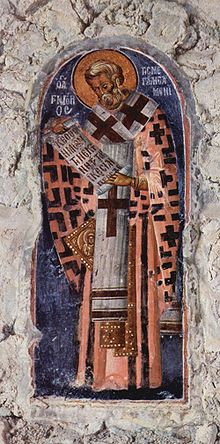Phelonion
The phelonion (Greek: φαιλόνιον, plural, φαιλόνια, phailónia; Latin: paenula, Russian: Фело́нь - Felón’) is a liturgical vestment worn by a priest of the Byzantine Christian tradition.
Like the chasuble, the phelonion was originally a sort of poncho, a conical round vestment with a hole in the middle for the head, which fell to the feet on all sides.
In its present form (dating from about the 15th century) the front is largely cut away (from about the waist down) to facilitate the movements of the priest's hands.
[1] The oldest surviving sources depicting the polystavrion as used by bishops are certain manuscripts from the late eleventh and early twelfth centuries.
This phenomenon was later repeated with the sakkos and the mitre, which also started off as worn only by the highest-ranking patriarchs and then trickled down to the rest of the hierarchy.
The Greek-style phelonion is, generally speaking, worn by those with a historical and geographical closer tie with the Patriarch of Constantinople, which would include most Eastern Orthodox Christians in the Middle East, Greece, the Balkans, Romania, Bulgaria, as well as Greek-Catholics and Orthodox in western Ukraine.
In Oriental Orthodoxy, the phelonion is often only clasped at the neck, and is thus more open than the Byzantine-style, resembling a Western cope.
Its various names are phanolion (Coptic), paynā (Assyrian), phayno (Syriac Orthodox), šurdzar (Armenian) and kāppā (Ethiopian).



